Ponds sometimes develop puzzling conditions. Muddy water, surface films, foam and slimes may develop seemingly without cause, but these conditions are the result of physical, biological, or chemical factors or some combination of these factors. This page discusses some of these conditions and the factors that cause them to develop in stormwater ponds.
-
Muddy Water
Several factors cause stormwater ponds to become muddy. The most common factor is erosion of soils either from runoff of exposed soils in the community or from unstable pond banks that are scoured by wave energy. It is to be expected that while a development is still under construction, its ponds are likely to be muddy. Also, ponds that do not have a vegetated border are likely to be muddy, especially after windstorms. The other most common cause of muddy water in stormwater ponds is biological, the result of fish, turtles, or waterfowl. Common carp (not triploid grass carp) cause muddy water because they stir bottom sediments as they feed. Sometimes the spawning of bass causes muddy water in early spring (March-April) as they bed. Likewise, bedding of bream may result in muddy water during the summer months. Ducks, and to a lesser degree geese, also muddy pond water as they sift through sediments for invertebrates and uproot submerged vegetation. Ponds with more than two ducks per acre are more likely to develop muddy water conditions. Rapid changes in water chemistry may result in muddy water or rapid changes in water color as sediments become resuspended. Ponds may become muddy with a rapid change in pH, which may occur as a result of a pollutant that has washed into the pond or the rapid development of an algal bloom. Turbidity and muddy water also may coincide with a turnover event as the rapid mixing of water resuspends sediment. In ponds that are supplemented with well water, turbidity may result from a change in the water source.
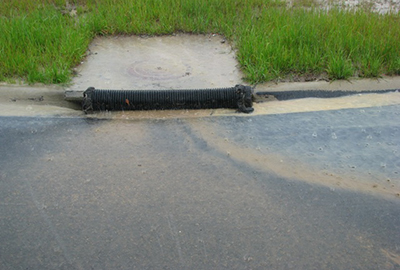
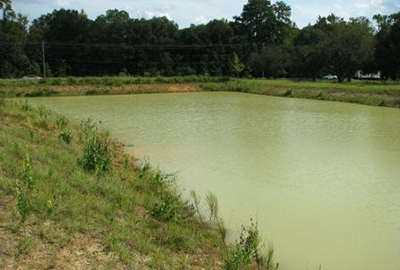
-
How can muddy water be cleared?
Muddy water in stormwater ponds is usually a temporary condition. Once construction is complete, grass and vegetation prevents erosion on the lots and along the pond banks, and stormwater ponds usually clear. At certain times of the year, they may develop muddy water, but the condition usually is short-lived because sediments either settle out or are flushed from the system during the next storm. Eliminating waterfowl is important with ponds that have large populations of ducks or geese (see section on Controlling Waterfowl). Stabilizing the banks with vegetation also is very important for preventing muddy water (see section on Shoreline Vegetation). If a pond remains muddy long after construction is complete, the community may need to consult with an engineering firm about a filtration system to remove suspended sediment or an additive that will flocculate clay particles out of the water. Homeowners or HOA members should not apply any additives to stormwater ponds without consulting the local municipality and the site engineer. It is not recommended to add straw or hay to stormwater ponds to remove suspended sediment because the loose straw can clog the outlet and decay of the straw material can cause other water quality problems and increased sedimentation.
-
Surface Films and Sheens
Surface films result when insoluble substances enter the pond. These substances come from a variety of physical, chemical, or biological sources.
1) Pollen and atmospheric dust are common causes of surface films, especially in the spring and fall. As trees and other plants flower in the spring, the resulting pollen can coat not only the pond, but just about every other surface in the neighborhood. Many trees such as pines and oaks are wind pollinated and broadcast large volumes of pollen into the air. Spring showers wash pollen into ponds where it floats and forms a yellow-green surface film that tends to dissipate within a few weeks. The condition may recur in the fall.
2) Films also are formed by the growth of certain kinds of blue-green algae, a particularly bad form of algae to have in a pond (See section on Planktonic Algae). Films formed by blue-green algae are usually bright green and form swirls and bands as they move over the pond with the wind. On rare occasion the pond may develop a bright red or blood red film which is the result of the growth of "red algae."
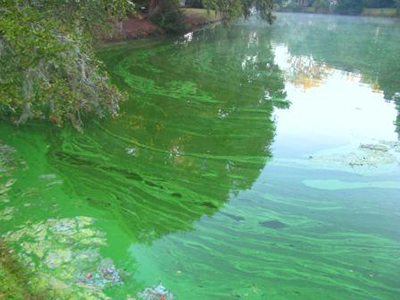
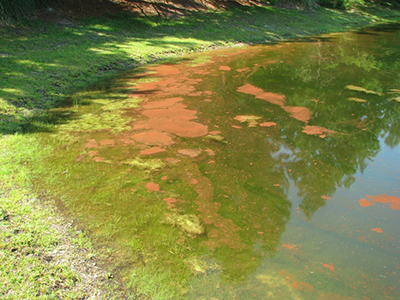
3) Hydrocarbons and oils are usually the other source of surface films in ponds. Oils are produced naturally by the decay of leaves, algae and organic matter, but these oils behave differently from cooking oil or motor oil. To determine if the oil sheen you see on your pond is from a natural organic source, poke it with a stick. If it is from the decay of leaves and other organics, it will most likely crack and shatter like a thin layer of glass and will not reform as the stick is removed. If it reforms or does not shatter, it is likely from automotive or cooking oils that have washed into the pond.
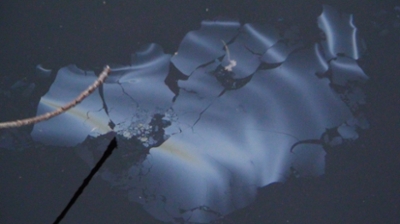
4) Finally, surface films may be the result of insoluble compounds in the soil. Soil-based films usually accompany muddy water, are similar in color and will dissipate as the muddy water clears. Eliminating the cause of the muddy water will usually eliminate this type of surface film.
-
How are surface films removed from ponds?
Very little can be done to remove a surface film from a stormwater pond once it has spread across the pond. If it is biological in origin (pollen or algae), it usually will dissipate or biodegrade on its own within a couple of weeks. If the film is the result of soils and muddy water, the problem may persist until erosion can be stopped or the source of the muddy water is eliminated. Oil films can be managed and involve a two-step process. First, oils can be removed from the pond surface using oil absorbing socks and booms. If the inlet where the oil is entering the pond can be identified, it should be protected by floating booms that will quarantine the oil before it disperses across the pond. Second, the source of the oil must be eliminated. This means that the catch basins need to be inspected for evidence of oil dumping into storm drains, or the streets and driveways need to be inspected for evidence of an oil spill. If a spill or illicit discharge is identified, the community may choose to hire a mobile pressure washer who can clean the surface AND reclaim the washwater that contains the oil so that it does not wash to the storm drain or to the pond.
-
Foam
Foams that form on the surface of stormwater ponds may be the result of illicit discharges of soap and detergents (see image on the left), or they can be formed naturally, usually in association with algae blooms. All plant cells contain natural surfactants that change water surface tension. After an algae bloom occurs and the algae begin to die, their cells rupture and release these natural surfactants into the water. Add some current or wave action to this mixture and this water can begin to form a froth or foam (see image on the right). This is the most common reason for the formation of "sea foam" at the beach. Natural foams also form in water with a lot of organic matter such as in black water rivers and swamps in the coastal plain. All of the leaves and woody debris that fall in swamps decay and release their natural surfactants into the water. This is the same reason tea and coffee form a froth on the surface when being boiled.
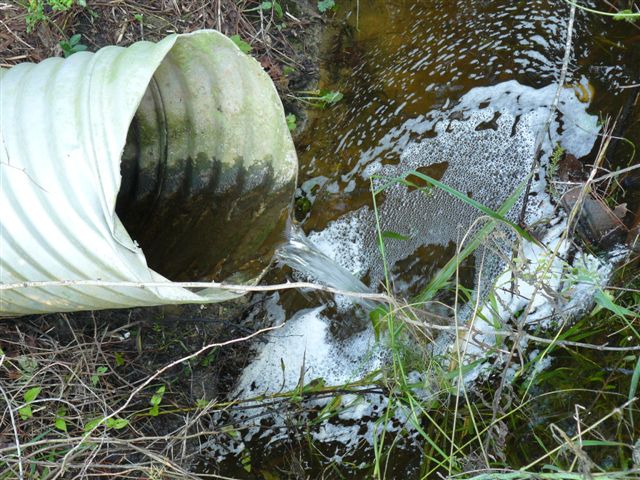
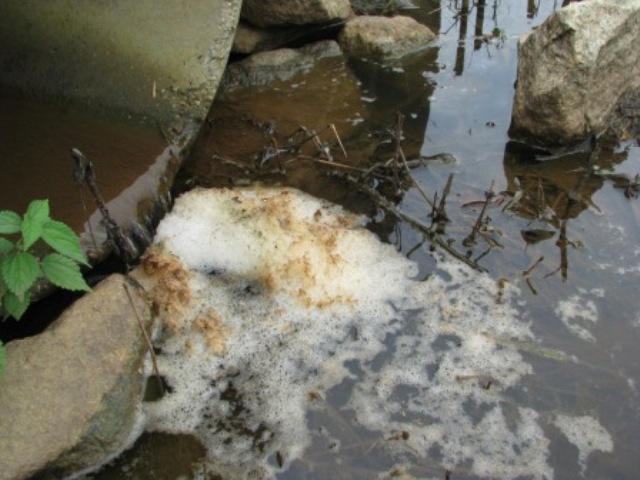
How can I tell the difference between foams from detergents and natural foams?
The image on the left is the result of illicit detergents poured into a storm drain. The image on the right is from natural organic decomposition in the water. The two sources usually can be determined by closer inspection of the foam. Soaps and detergents usually contain substances called brighteners, which help the detergent keep a bright white color and prevent staining. Foam formed by soaps and detergents will retain its bright white color for many days regardless of the color or clarity of the water. Natural foams, on the other hand, are formed by organics that rapidly biodegrade. For this reason, natural foams usually begin to turn brown within hours of being formed. Another way to tell them apart is to look at the individual bubbles in the foam. Soaps are more efficient surfactants so they can create larger bubbles, so bubbles in soapy foams often are large and of variable size. Natural foams cannot create large bubbles easily, so they tend to have small bubbles that are more uniform in size. Last, soapy foams are able to disperse easily, so they often spread out from their source. Natural foams do not disperse as well, so they tend to stay close to the source. -
Slimes
Slimes are usually the result of biological activity in the pond. They often are formed by the growth of algae or microbes at the water's edge or on the bottom in the shallow areas of the pond. These types of slimes are most often green or black, and are familiar to most residents. In some ponds, residents may complain about the development of an orange-brown gelatinous substance on the bottom near the shoreline (See picture to the right). The substance is clumpy and breaks apart easily. This substance being described is most likely colonies of iron-loving bacteria (Acidithiobacillus ferroxidans) that are taking advantage of oxidized iron in the water (See image on the right). The gelatinous colonies of iron-loving bacteria most commonly form in ponds that are being supplemented with well water that is high in iron, a common condition in South Carolina well water. Iron-loving bacteria may affect pH in a pond, but they are not known to be toxic and should not be expected to cause impairments in ponds. The presence of iron bacteria near an inlet might indicate that the pipe leading to the inlet has cracked or separated and is allowing ground water to enter the pipe. If large colonies of this type of bacteria are near a particular inlet, you should have the pipe leading to that inlet inspected for a separation to prevent a sink hole or blockage from forming.



